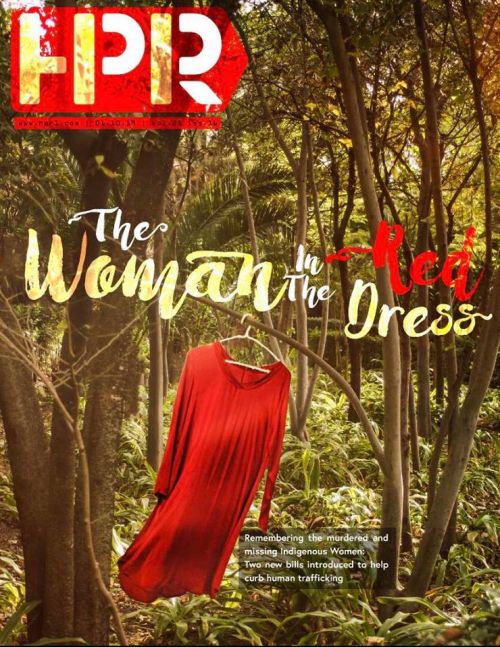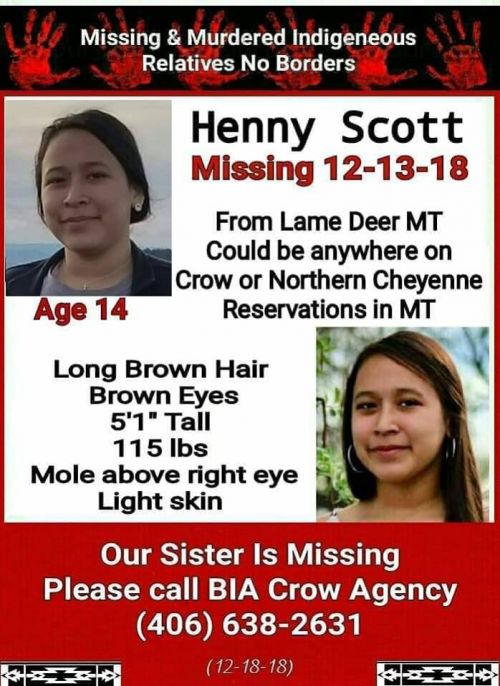News | January 9th, 2019

FARGO– Annita Lucchesi began researching the cases of missing and murdered Indigenous women with a hand broken from domestic violence. Never before compiled into a single database by any law enforcement agency, her task is daunting, even without the pain.
“I almost became one of the women on this list,” Lucchesi said. “Having escaped domestic violence I felt the responsibility to create this resource. I thought someone was already doing it, there are lots of lists out there, but none of it matches, none of it collects or is updated frequently.”
So far, dating back to 1900, she’s uncovered more than 3,500 Native women and men who were murdered, or who went missing. The names are predominantly from the 1980s until present day, and her work is only just beginning.
“People are doing a better job of documenting cases, and particularly the community is doing better publicizing cases than we were five years ago,” Lucchesi said. “Hard to know if the numbers are increasing, but awareness of it certainly is.”
Lucchesi is a Southern Cheyenne doctoral student and primary researcher for the Urban Indian Health Institute project, which as of late last year has spent approximately $20,000 on the research. She is one of the keepers of the statistics, and has spent the past few years compiling the data. Her work, which she will continue until the 28-year-old has grandbabies on her lap, includes government statistics, expensive Freedom of Information Act request results, news archives, news media, social media posts, and community discussions.

Such data is part of what former Senator Heidi Heitkamp’s Savanna’s Act is supposed to protect, if the bill passes the U.S. House of Representatives. The bill passed unanimously in the U.S. Senate with 17 co-sponsors, not including North Dakota’s own Senator John Hoeven’s name. By all appearances the bill seemed to be a nonpartisan proposal with wide support, but it stalled in the House after one man, retiring Virginia Senator Bob Goodlatte, stopped it cold. Savanna’s Act is named after Savanna Lafontaine Greywind, who was murdered for her unborn baby during a fetal abduction in an apartment upstairs from where she lived in Fargo.
Lucchesi has found roadblocks navigating the red tape, especially since she’s Native and a woman, she said.
“They don’t see us as human beings, or as citizens of the same community that they are a part of,” Lucchesi said. “Police are so used to dehumanizing Native people, see them as degenerates… there is also misogyny in this as well. The ones that have been bad they’ve been very dismissive of me not only because I am a Native, but because I am a woman. They assumed I was a little Native girl doing something I didn’t care about.
“They couldn’t fathom a Native woman would be doing something important to the nation.”
Despite the roadblocks and high-priced FOIA receipts, which she said are coming primarily from Nebraska State Patrol, Alaskan police departments, and the Billings Police Department, she remains undaunted. She’s requested information from Fargo and Bismarck police departments, but so far, has received no information because police do not record the required information, she said.
“If anything it’s encouraging because it shows that we’re continuing to strive to do the best we can for our people in the face of insurmountable odds,” Lucchesi said.
A twisted culture
The choking bruise marks around Amanda Myhre’s neck should have been evidence enough for Fargo police to arrest her former fiancé. Instead, two female police officers first suspected her, Myhre said.
“My ex fiancé physically abused me one time and he attempted to choke me and the cops were called and they didn't charge him,” Myhre, a North Dakota resident and a registered member of the Standing Rock Sioux Nation, said. The assault occurred more than 10 years ago, but the memories still haunt her.
Her fiancé, six feet tall and weighing nearly 200 pounds at the time, became jealous that someone from work was paying attention to her. An argument ensued, and he tried to strangle her, she said. At about 120 pounds and five feet, two inches tall, Myhre fought back, nicked his cheek with a fingernail.
“I was told by the police officer that I had 10 seconds to explain,” Myhre, who was 23 when the assault occurred, said. “I was bawling and hysterical and couldn't talk. They didn’t listen, they appeared to be more attentive to him and seemed to dismiss me.”
Until now, raw data pertaining to the numbers of missing and murdered Indigenous women has been difficult to obtain because statistics did not exist. No one seemed to care. Cases of missing and murdered Native men and women frequently go unprosecuted; case files are forgotten to gather dust. Criminals kill with relative impunity taking advantage of the convoluted jurisdictional laws involving the nation’s First Peoples.
Survivors like Myhre have had to alter their lifestyles, sometimes living in fear for the rest of their lives because in many cases crimes go unprosecuted, or Native people are targeted, according to Annita Lucchesi. A relative of hers on probation was stalked by a parole officer and re-arrested after finding an empty beer can in the backyard, she said.
“The failure to pass Savannah's Act continues to allow perpetrators like these two to get away with these vicious acts of violence,” Myhre said, referring to Savanna’s murderer and co-conspirator, Brooke Lynn Crews and William Henry Hoehn.
“This is a silent epidemic that has been happening for years, and unfortunately, it took a life to recognize the magnitude that women face, especially Native women face. How can we continue to rely on those who are supposed to protect us?”

MMIW
Since Savanna Greywind’s murder, red has been the color to remember her and raise awareness for the missing and murdered Indigenous women. The issue, however, predates 2017 as Natives have been trying to raise awareness of their since the 1960s, Lucchesi said.
Hundreds of Native women are currently missing, according to a recent report made public by the Urban Indian Health Institute. The Urban Indian Health Institute is a Native organization that seeks to decolonize data pertaining to the nation’s Indigenous.
Lucchesi’s statistics show more than 506 current cases of missing or murdered Indigenous women. So far 66 percent of the cases she found end in murder. A third of the reported cases involve girls ages 18 and under, and 65 percent are victims of sexual assault, domestic violence, or sex trafficking, and were in foster care.
Natives comprise 1.3 percent of the nation’s population of 327 million, according to a 2018 report made public by the U.S. Census Bureau. Excluding runaways, approximately 46,500 people have been reported missing to the Federal Bureau of Investigation.
By the end of 2017, the FBI was involved in 633 missing person cases according to the FBI’s National Crime Information Center, or NCIC. A total of 10,642 Native men and women were listed as missing in 2017, of which 8,519 were under the age of 21, according to the NCIC. The number of missing has been steadily increasing through 2007, 2010, 2014 until current day.
Too many of the cases end in bitter disappointment. Most recently Henny Scott, 14, of Lame Deer, Montana, on the Northern Cheyenne Reservation, was found dead after being missing for several weeks. Volunteer searchers found her body covered in snow near a house by Muddy Creek area west of Lame Deer.
Hania Aguilar, 13, kidnapped on November 5, 2017, was found dead in North Carolina three weeks later. Here in North Dakota, Savanna Greywind’s body wasn’t found until more than a week after she was initially reported missing.
Overall, violent crimes have increased by approximately seven percent since 2013 inside the United States, according to NCIC statistics. Reported rape cases skyrocketed during the same time period with 135,755 cases reported last year, a 19.4 percent increase since 2013.
In Montana, Native Americans account for 30 percent of the missing girls and women, 22 out of 72 people, even though they represent only 3.3 percent of the state’s population, according to a 2017 analysis released by the state’s Department of Justice.
On some reservations, Native women are murdered at a rate more than 10 times the national average and more than half of Alaska Native and Native women have gone through sexual violence, according to the U.S. Justice Department.
For people like Lucchesi the statistics are more than numbers. Each case is personal, and she and others are trying to break the narrative and decolonize the information.

Decolonization
Abigail Echo-Hawk, director of the Urban Indian Health Institute and member of the Pawnee Nation of Oklahoma, spoke at the George Washington University two days after the Urban Health Institute issued a report to Congress in November on missing and murdered Indigenous women.
The colonial government uses data to harm and assimilate Native people and culture, to show that the nation’s Indigenous are weak or disorganized, according to Echo-Hawk.
“Their history is not my history,” Echo-Hawk said. “In my history I was loved, I was cared for, I know the names of my ancestors from seven generations ago who prayed for me to be here today. We are colonially underserved, we are institutionally underserved; we are not historically underserved.”
From genocide to forced assimilation, national policy has historically been to subdue and suppress Native cultures.
“About 78 percent of Native people are living off reservation lands… and we know that there are many reasons people like myself currently do not live in their tribal home,” Echo-Hawk said. “We know that in many of our urban settings like Seattle, Denver, New York, there were programs meant to assimilate and meant to eradicate our people that removed them through this program that removed them from the reservations and moved them to urban settings, and because of that we’ve seen continuous cycles of poverty, of violence, and of resiliency that I think overcame all of those things, because regardless of where they put us, we found each other.”
Government research differs from Native research, Echo-Hawk said. She plans to reclaim Indigenous value systems and not rely solely on Western numbers.
“Western dialogues of when history started, who was responsible for data and how it was supposed to be gathered, we don’t have to do it their way,” Echo-Hawk said. “We have our own way. We’ve always had our own way. We would go out to this lake and count the number of beavers that were around this lake and we counted them so we knew how many we could hunt in the winter so they could be there again in the spring. We used that research for the health and wellbeing of our people.”
Every missing or murdered case is sacred, and her organization has a responsibility to the story behind each case.
Annita Lucchesi agrees, saying her work comes from her heart.
“It means everything to us… to honor the grief that the families are going through,” Lucchesi said. “Where does she come from, who does she belong to, how do we honor her? This was a labor of love. My mother says now all the police departments hate you. And I said ‘they weren’t very helpful before either.’
“The simple answer is that the FBI doesn’t care about the data, and we do. That’s the spirit of decolonizing data, it’s data by and for Indigenous people and it’s empowering Indigenous people to research the things in service of our communities and that benefits our people in a way that is consistent with our cultural values and teachings, which is something the FBI or an law enforcement agency isn’t capable of doing, and that shapes the kinds of questions they ask, the kinds of data they collect, and the relationships they build with the communities they’re doing research in.”
[Editor’s note: The red dress became a symbol of MMIW through a conceptual art project by Winnipeg based artist Jaime Black in response to the large number of MMIW in Canada.]
July 15th 2025
July 7th 2025
June 9th 2025
April 30th 2025
April 24th 2025
__293px-wide.jpg)
_(1)__293px-wide.jpg)

__293px-wide.jpg)

